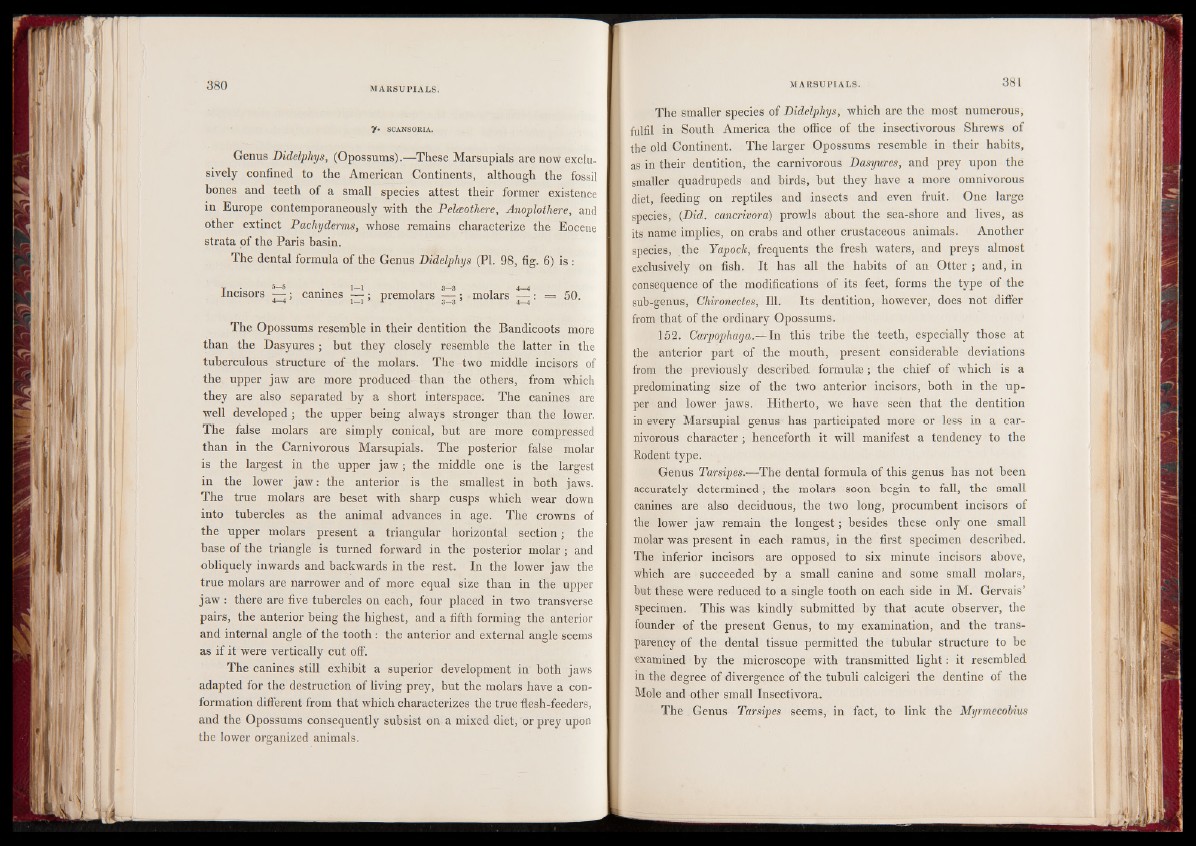
380 MARSUPIALS.
> • SCANSOBIA.
Genus Didelphys, (Opossums).—These Marsupials are now exclusively
confined to the American Continents, although the fossil
bones and teeth of a small species attest their former existence
in Europe contemporaneously with the Pelceothere, Anoplothere, and
other extinct Pachyderms, whose remains characterize the Eocene
strata of the Paris basin.
The dental formula of the Genus Didelphys (PI. 98, fig. 6) is :
Incisors — ; canines — ; premolars — ; molars — : = 50.
The Opossums resemble in their dentition the Bandicoots more
than the Dasyures; but they closely resemble the latter in the
tuberculous structure of the molars. The two middle incisors of
the upper jaw are more produced than the others, from which
they are also separated by a short interspace. The canines are
well developed ; the upper being always stronger than the lower.
The false molars are simply conical, but are more compressed
than in the Carnivorous Marsupials. The posterior false molar
is the largest in the upper jaw ; the middle one is the largest
in the lower jaw: the anterior is the smallest in both jaws.
The true molars are beset with sharp cusps which wear down
into tubercles as the animal advances in age. The crowns of
the upper molars present a triangular horizontal section; the
base of the triangle is turned forward in the posterior molar; and
obliquely inwards and backwards in the rest. In the lower jaw the
true molars are narrower and of more equal size than in the upper
jaw : there are five tubercles on each, four placed in two transverse
pairs, the anterior being the highest, and a fifth forming the anterior
and internal angle of the tooth: the anterior and external angle seems
as if it were vertically cut off.
The canines still exhibit a superior development in both jaws
adapted for the destruction of living prey, but the molars have a conformation
different from that which characterizes the true flesh-feeders,
and the Opossums consequently subsist on a mixed diet, or prey upon
the lower organized animals.
MARSUPIALS. 381
The smaller species of Didelphys, which are the most numerous,
fulfil in South America the office of the insectivorous Shrews of
the old Continent. The larger Opossums resemble in their habits,
as in their dentition, the carnivorous Dasyures, and prey upon the
smaller quadrupeds and birds, but they have a more omnivorous
diet, feeding on reptiles and insects and even fruit. One large
species, {Did. cancrivora) prowls about the sea-shore and lives, as
its name implies, on crabs and other crustaceous animals. Another
species, the Yapock, frequents the fresh waters, and preys almost
exclusively on fish. It has all the habits of an Otter ; and, in
consequence of the modifications of its feet, forms the type of the
sub-genus, Chironectes, 111. Its dentition, however, does not differ
from that of the ordinary Opossums.
152. Carpophaga.—In this tribe the teeth, especially those at
the anterior part of the mouth, present considerable deviations
from the previously described formulae; the chief of which is a
predominating size of the two anterior incisors, both in the upper
and lower jaws. Hitherto, we have seen that the dentition
in every Marsupial genus has participated more or less in a carnivorous
character; henceforth it will manifest a tendency to the
Eodent type.
Genus Tarsipes.—The dental formula of this genus has not been
accurately determined; the molars soon begin to fall, the small
canines are also deciduous, the two long, procumbent incisors of
the lower jaw remain the longest; besides these only one small
molar was present in each ramus, in the first specimen described.
The inferior incisors are opposed to six minute incisors above,
which are succeeded by a small canine and some small molars,
but these were reduced to a single tooth on each side in M. Gervais’
specimen. This was kindly submitted by that acute observer, the
founder of the present Genus, to my examination, and the transparency
of the dental tissue permitted the tubular structure to be
examined by the microscope with transmitted light: it resembled
in the degree of divergence of the tubuli calcigeri the dentine of the
Mole and other small Insectivora.
The Genus Tarsipes seems, in fact, to link the Myrmecobius